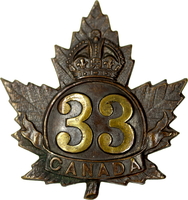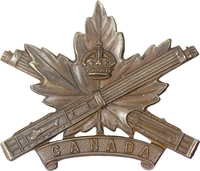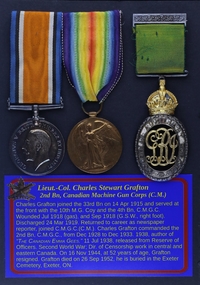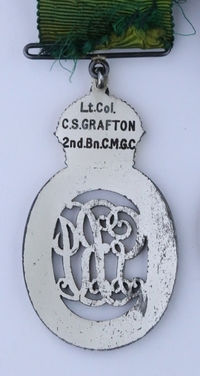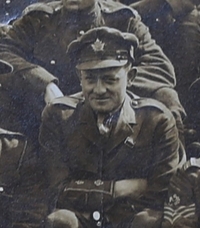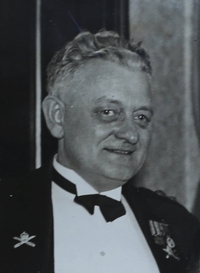
Lt.-Col. Charles Stewart Grafton, V.D.
26th Regiment (Middlesex Light Infantry)
33rd Canadian Overseas Battalion, C.E.F.
135th Canadian Overseas Battalion, C.E.F.
4th Battalion, Canadian Machine Gun Corps, C.E.F.
2nd Battalion, Canadian Machine Gun Corps, C.M.
By: Capt (ret'd) Michael M. O'Leary, CD, The RCR
Charles Stewart Grafton was born on the 5 Aug 1892, in Blanchard Township, Ontario. The Grafton family can be found in the 1901 canadian Census. Father George, and innkeeper, and mother Mary J. Have only one child (Charles) and a single domestic servant living in the household. Charles can be found in the 1911 census. Working as a bookkeeper, he is living as lodger in London, Ontario, but his parents no longer appear in the searches.
At 23 years of age, Charles Grafton was working as newspaper reporter when he attested for overseas service with the 33rd Battalion of the Canadian Expeditionary Force at London, Ontario, on 14 Apr 1915 (regimental number A-1295). On his attestation paper, Grafton identified his aunt as next-of-kin, Mrs. H. Germyn (sic), who was living at Cape Croker, Ontario. Medically examined on enlistment, Grafton was described as 5 feet, 6 inches, tall, with a 35-inch chest measurement. He had a fair complexion, blue eyes and brown hair. As a soldier of the 33rd Battalion, Grafton spent his first months in the army training at Carling Heights, the present day location of Wolseley Barracks in London, Ontario.
On 2 Sep 1915, Charles Grafton was struck off the strength of the 33rd Canadian Battalion and selected for officer training. He was a provisional Lieutenant of the 26th Regiment (Middlesex Light Infantry) when he passed his Lieutenant's examinations on 13 Oct 1915. As with other officers of Militia units, Grafton would remain on the rolls of his unit while seconded with the Canadian Expeditionary Force (C.E.F.) for wartime service.
Grafton was gazetted as a Supernumerary Lieutenant on 20 Nov 1915 and signed his officers' Declaration Paper for service in the 135th Overseas Battalion on 23 Nov 1915. This document provides a few details on his pre-service life that were not recorded on his earlier Attestation Paper. Grafton was living at 411 King St. in London and noted both prior service of six months with the 33rd Battalion as well as serving in the 26th Middlesex Regiment at the time of his declaration.
On 26 Feb 1916, Grafton completed a Certificate of Military Qualification on the Colt Machine Gun. This training was to set a cornerstone for the remainder of his military career.
In a surviving scrapbook of Grafton's, there are two group photos of CEF soldiers. One is the machine gun section of the 33rd Canadian Infantry Battalion. The other is the machine gun section of the 135th Overseas Battalion. Grafton's appearance in both of these groups was the start of a long military career with machine guns, both overseas and in the Militia after the war. Grafton's training in the machine gun section of the 33rd Battalion as a soldier undoubtedly also led to his appointment as the Machine Gun Officer of the 135th Battalion.
Lieut. Charles Grafton sailed for England as an officer of the 135th Overseas Battalion, CEF. The unit embarked in the S.S. Olympic at Halifax on 22 Aug, 1916 and arrived at Liverpool, England, on 30 Aug 1916. Once in England, and with the being unit absorbed into the ever-changing world of the reinforcement stream, Grafton was posted to the 134th Battalion at Witley on 15 Oct 1916. He did not remain long with this unit either, but was sent to the Canadian Military School at Shorncliffe, attending course from 3 Jan to 3 Mar 1917.
At the Canadian Military School, Grafton completed a course of instruction and passed examinations in Tactics, Topography, Law, Administration, Organization, Engineering, and Drill. He also received instruction in Use of Grenades, Machine Gun Tactics, and Musketry. Grafton achieved a "Distinguished" level in Topography, no doubt a useful achievement for a developing machine gun officer. Five days after the completion of training, on 13 Mar 1917, Grafton was posted to the Canadian Machine Gun Depot at Crowborough. With this move, Grafton found himself in the Corps that would form the foundation of his military career.
Grafton remained with the C.M.G. Depot for some months, likely in a balance between taking the necessary courses to become a machine gun officer, and responsibilities as a Depot officer. In June, 1917, he was hospitalized for 18 days to undergo a tonsillectomy and to recover from the surgery. On 13 Oct 1917, he was struck off the strength of the Depot on proceeding overseas, that is to say, crossing the Channel to France. Arriving in France the next day, Grafton joined the Machine Gun Reinforcement Pool to wait his next transfer in the direction of the firing line.
He did not have to wait long. On 27 Oct 1917, Grafton was processed in and out of the Canadian Corps Reinforcement Centre and transferred to the 10th Machine Gun Company, joining the unit in the field on 29 Oct 1917. This unit was the Machine Gun Company of the 10th Canadian Infantry Brigade.
Grafton enjoyed a period of leave in early 1918, proceeding to the UK for 14 days on 13 March 1918. Shortly after his return from leave in the spring of 1918, the M.G. Companies of each Division were combined to form divisional Machine Gun Battalions, effective 19 March. As a result, Grafton's parent unit became the 4th Battalion, Canadian Machine Gun Corps. The 4th Battalion, C.M.G.C. was formed from 10th, 11th, 12th, and 16th M.G. Companies, the first three having belonged to the correspondingly numbered brigades and the last previously having been the 4th Division's divisional M.G. Company.
In July 1918, Grafton suffered the effects of battlefield gas. The incident left him blind for two days although the inflammation had mostly subsided by the third or fourth day, leaving him to suffer for a further month from granular conjunctivitis. He would still be affected by this wounding when he was examined at the time of his discharge from the CEF.
Having served continuously with his unit since arriving in Oct 1917, Grafton was wounded in action on 28 Sep 1918, suffering a "slight" gunshot wound of the right foot. He was evacuated from the continent within days, which required his transfer from the M.G. battalion to the Canadian Machine Gun Pool, which would administer him while in hospital and recovery, and until he rejoined his unit. The C.M.G. Pool, detached Grafton to the C.M.G.C. Depot at Seaford on 1 Oct 1918.
Grafton was admitted to the 2nd West General Hospital, Manchester, on 2 Oct 1918. From there, he was transferred on 18 Oct to the Canadian Convalescent Officers Hospital at Matlock until the 23rd of October. On 30 Nov 1918, Grafton was struck off the strength of the Canadian Machine Gun Depot to the CEF in Canada. Effective that same day, he was taken on the strength of No. 1 District Depot at Wolseley Barracks, London Ontario.
Effective 24 Mar 1919, Charles Grafton was struck off the strength of the CEF on general demobilization. He was recorded as returning to the Active Militia Unit he had belong to before enlisting, the 26th Middlesex Regiment. He was almost immediately engaged in the formation of the new Canadian Machine Gun Corps within the Active Militia of Canada. For 183 days of active service, Grafton would receive a War Service Gratuity of $549. This was paid to him in five installments between April and August, 1919.
Back home in Canada, Grafton started to pick up the threads of his civil life. On 12 Nov 1919, he was married in Toronto to Bernice Agnes Sibbald, a nurse from Duluth, Minnesota. The 1921 Canadian Census shows the couple back in London, Ont., with a nin-month-old daughter, Mary Virginia.
A newspaper reporter at the time of his enlistment for service in the Great War, Grafton would return to that career for the rest of his life. The 1921 census recorded him as an Assistant Editor. Grafton started in the profession with the London Free Press. He later went to the London Advertiser, where he was the sports editor for 18 years, until 1938.
Grafton also continued to serve in the Canadian Militia after the First World War, joining the newly formed Canadian Machine Gun Corps in the Militia shortly after the war. The following dates showing the path of Grafton's career after the Great War are noted in his CEF service record:
- Capt, 2nd Bde, CMGC, 14 Dec 1919
- Maj, 2IC, 2 M.G. Bn, 15 Nov 1920
- Lieut.-Col., 2 M.G. Bn, 14 Dec 1928
- Lieut.-Col., 2 (Res) M.G. Bn, 14 Dec 1933
Grafton attended a course at the Canadian Small Arms School, Ottawa, from 20 Jul to 15 Aug 1925. This course qualified him to be an instructor on the Vickers Machine Gun, the Range-Finder, and the revolver. The September, 1925, edition of the Militia List summarized Grafton's career as follows:
"GRAFTON, Charles Stewart (Major 2 M.G. Bn.)
"The War of 1914-21. France and Belgium 14/10/17 to 10/9/18. Wounded. British War Medal, Victory Medal."
Charles Grafton was promoted to Lieutenant-Colonel and appointed to command the 2nd Battalion, CMGC, in 1928. Having served in the unit since its creation, Grafton took over command from Lieut.-Col. E.N. Chisholm, V.D. While commanding the 2nd Battalion, CMGC, Grafton was awarded the Canadian Auxiliary Forces Officers Decoration.
In 1929, Grafton, along with other officer veterans of the Great War who resided in London, Ontario, worked to establish a new branch of the Canadian Legion. Their efforts to do so came about after being shut out of executive positions in the local branch of the Legion over philosophical differences with Other Rank veterans. In March 1929, a new branch charter for Branch #145, Vimy Branch, was issued which identified the following founding members: Col. Ibbotson Leonard; Lt. Cols. E.G. Shannon, W.H. Kippen, Charles Grafton; Majors D.J.H. Ferguson, H.K. Ingram; Captains A.M. Dillon, M.M. Dillon, J.M. Watt, D.B. Weldon, Harry Dickinson; and Lieutenants M.P.A. Hare, Lloyd Chapman, and George Cogdon.
Grafton relinquished command of the 2nd Battalion, CMGC, on 14 Dec 1933. He was replaced by Maj. M.M. Dillon, M.C. and Grafton took command of the 2nd (Reserve) Battalion, CMGC. "Reserve" units in the Militia at the time were identified on the order of battle but only authorized to hold the unit's officers on strength.
A clipping in Grafton's scrapbook dated 5 Nov 1936, reconnects his story to the earliest days of his Great War service. The article described the circumstances surrounding the death of his aunt, identified as "Mrs. H Germyn" in his soldier's attestation paper under next-of kin, and now clarified as Mrs. Margaret Jermyn. Involved in a single vehicle accident near Orangeville, Ontario, with three others in the car. Hospitalized, Mrs. Jermyn showed appearances of recovery in the first two days, but then she took a downturn and succumbed to her injuries. The article also clarifies the connection between Grafton and a certificate recognising his First World War service presented to him by the Cape Croker Indian Reserve (which accompanied his medals). The clipping states: "Mrs. Jermyn, whose maiden name was Margaret Grafton, lived in Wiarton previous to her husband's appointment as Indian Agent at Cape Croker."
In 1938, the history of the Canadian Machine Gun Corps (CEF), written by Charles Grafton and titled "The Canadian Emma Gees," was published by the C.M.G.C. Association. The volume was sold by The Legionary Library in Ottawa for $1.50 postpaid. Grafton's work on the history of the CMGC was anchored by the unpublished 900-page manuscript, "History of the Canadian Machine Gun Corps, C.E.F.," previously prepared by two officers of the CMGC; Major Harry Tremaine Logan and Captain Mark Roberts Levey. Logan was a Rhodes Scholar who was awarded the Military Cross for service in the CMGC in the Great War and afterward rose to the rank of Lieutenant Colonel with the Canadian Officers Training Corps. Levey, a surveyor who afterwards studied medicine and taught at the University of Alberta's medical school, becoming the director of their Division of Ophthalmology and Otolaryngology.
Grafton's military service ended on 11 July, 1938, when he was released from the Reserve of Officers having failed to meet the requirement of continued service, which was to annually identify his intention to remain listed in the Reserve of Officers.
Grafton moved to Timmins in 1938, where he was employed by the Timmins Daily Press as managing editor for two years. He left Timmins in 1940 to join the staff of the Globe and Mail in Toronto. Shortly after this change of jobs, Grafton was appointed the news censor for Ontario, beginning his Second World War service in the Directorate of Censorship for which he would work in central and eastern Canada. On 16 Nov 1944, at 52 years of age, Grafton formally tendered his resignation to the Office of the Chief, Censors of Publications.
Suffering from frail health after having a heart attack in 1945, Lieutenant Colonel Charles Grafton, V.D., died on 26 Sep 1952. He was survived by his wife Bernice and a son and daughter. Charles Grafton buried in the Exeter Cemetery, Exeter, Ontario, where he lays beside Bernice.

The CMGC and The RCR
Charles Grafton's connection to the history and heritage of The Royal Canadian Regiment begins in 1936. That year, a major reorganization of the Canadian Militia was executed, which saw the dissolution of the Canadian Machine Gun Corps after 17 years on the order of battle.
An Army Headquarters Historical Section Report (No. 64, The Reorganization of the Canadian Militia, 1936) prepared in August, 1953, provides the following explanation:
These developments were to result in the disappearance-of the Canadian Machine Gun Corps (H.Q.S. 5902, vol 4: F.D. 17: Table for Infantry, Tanks & Machine Guns), a change recommended by the Canadian Machine Gun Corps Association (ibid: "Minutes of the Fourth Meeting of the conference of Defence Associations, 14/15 Feb 36", pp 5-14, 27-29 and 31). There was, however, to be an important increase in the number of machine gun units, since one extra battalion per infantry division (six in all) was retained additional to the 18 required to complete the infantry brigade organizations.
Notes in the Report's Annex describing the distribution of rifle and machine gun infantry battalions adds the following:
Originally, there were to be 77 infantry battalions, 72 of them for the 18 infantry brigades of the six infantry divisions and five for the fortress garrisons (H.Q.S. 5902, vol 3: C.G.S. to D.O.Cs., 25 Oct 33, Appx "I"). The figure of 72 was reduced to 54 by adoption of the War Office decision to have three infantry battalions and one machine gun battalion in each brigade (para 47).
The newly designated machine gun battalions, formed by amalgamation of existing Militia regiments with the headquarters and/or companies of the disappearing CMGC battalions, were identified by their official titles having the addition of "Machine Gun / (M.G.)." Among these, The Canadian Fusiliers (City of London Regiment), on 15 December 1936, was amalgamated with the 'Headquarters' and 'A Company' of the '2nd Machine Gun Battalion, CMGC' and redesignated 'The Canadian Fusiliers (City of London Regiment) (Machine Gun)'.
With that 1936 amalgamation, The Canadian Fusiliers also received the responsibility of perpetuating the 2nd Battalion, CMGC of the CEF. At the outbreak of the Second World War, some of the designated machine gun battalions of the infantry corps were employed as line infantry battalions, and some were fire support units with machine guns and mortars. The Canadian Fusiliers were among the former, although they would not lose the "Machine Gun" title until they were amalgamated with The Oxford Rifles in 1954.
That 1954 amalgamation would form the 'The London and Oxford Fusiliers (3rd Battalion, The Royal Canadian Regiment). This unit would undergo a further amalgamation with The Royal Canadian Regiment in 1958, becoming '3rd Battalion, The Royal Canadian Regiment (London and Oxford Fusiliers). The battalion would become the 4th Battalion in 1970 and formally drop the "(London and Oxford Fusiliers)" in May, 1990.
Through these amalgamations, the lineage of The Royal Canadian Regiment includes the amalgamated 2nd Battalion, CMGC (Canadian Militia), and the inherited rights and responsibilities of perpetuation of the 2nd Battalion, CMGC (CEF).
Battle Honours of the 2nd Battalion, Canadian Machine Gun Corps
Amiens, Arras 1918, Scarpe 1918, Drocourt-Quéant, Hindenburg Line, Canal du Nord, Cambrai 1918, Pursuit to Mons, France and Flanders 1918" –(General Order No. 123 of 1929)

Long Service Awards to the 2nd Bn, C.M.G.C. (C.M.)
The quiet years between the world wars were a period during which the only medals a member of the Canadian Militia might receive were commemoratives and long service medals. Eight long service awards to members of the 2nd Battalion, Canadian Machine Gun Corps, of the Canadian Militia, are recorded in the Library and Archives Canada Honours and Awards (1812-1969) database.
Colonial Auxiliary Forces Officers Decoration (V.D.) – Awarded to commissioned officers in the non-permanent active militia for 20 years of commendable service. It was awarded from 1901 until 1931.
- Lt.-Col Charles Stewart Grafton
- Lt.-Col E.N. Chesham
Colonial Auxiliary Forces Long Service Medal – This medal was awarded to non-commissioned personnel for 20 years of service (war years count double) in the non-permanent active militia, the Royal Naval Canadian Volunteer Reserve (RNCVR) and the Royal Canadian Air Force (RCAF) Auxiliary. Awarded between 1902 and 1931. Officers would receive this award if their initial qualifying time was as a soldier or NCO, but could no longer wear it if they later qualified for and received the Officers Decoration (unless they served long enough to meet the terms of each award without overlap).
- Major G. Thomas
- Captain H.G. McClintock
- Captain W. Nuttall
- Lieutenant R.H. Dennis
- Lieutenant J.J.M. Murray
- Armourer S.-Sergt. G. Eaton
Pro Patria
Visit a randomly selected page in The O'Leary Collection (or reload for another choice):
- The O'Leary Collection; Medals of The Royal Canadian Regiment.
- Researching Canadian Soldiers of the First World War
- Researching The Royal Canadian Regiment
- The RCR in the First World War
- Badges of The RCR
- The Senior Subaltern
- The Minute Book (blog)
- Rogue Papers
- Tactical Primers
- The Regimental Library
- Battle Honours
- Perpetuation of the CEF
- A Miscellany
- Quotes
- The Frontenac Times
- Site Map
QUICK LINKS
The O'Leary Collection—Medals of The Royal Canadian Regiment
Newest additions:
![]()
![]() SB-12725 Private Henry "Hank" Ard
SB-12725 Private Henry "Hank" Ard ![]()
WIA at Hill 187, Died of Wounds in Japan
![]()
![]() 2355331 Lance Corporal Albert Lorking
2355331 Lance Corporal Albert Lorking
Wounded in action, later a War Amps representative.
![]()
![]() 4334 / 477996 Pte Isaac Hamilton Wilcox
4334 / 477996 Pte Isaac Hamilton Wilcox
Permanent Force, South Africa, and C.E.F.
![]()
![]() 477019 Private Harold Ashcroft
477019 Private Harold Ashcroft
Transferred to the Tunnelers.
![]()
![]() 734231 Private Clark D. Thompson
734231 Private Clark D. Thompson ![]()
The older Thompson brother, killed in action.
![]()
![]() 733849 Private Norman Parker Thompson
733849 Private Norman Parker Thompson
The younger Thompson brother; post-war service in the Special Guard.
![]()
![]()
![]() A305 / 400305 Private Andrew Walker
A305 / 400305 Private Andrew Walker ![]()
"Previously reported Wounded, now Killed in Action."
![]()
![]() 823298 Pte Thomas Patrick Steele, M.M.
823298 Pte Thomas Patrick Steele, M.M. ![]()
… for gallant conduct in the field …
![]()
![]() P13066 Sergeant Harold Thompson
P13066 Sergeant Harold Thompson
Instrumental Soloist for over 20 years of Canadian Army service.
![]()
![]() 9609 / 477728 Private Albert Edward Piper
9609 / 477728 Private Albert Edward Piper
"Arrived from England as a STOWAWAY …"
